

Yogie Candra Bhumi
Spatial intelligence or visual spatial intelligence (spatial intelligence) is known as one of the basic cognitive abilities possessed by a person besides verbal and numerical intelligence (Wai et al. 2009). Spatial intelligence has many important roles that can influence a person's navigation in everyday life in perceiving objects and space, and can influence a person's success in various fields. Currently, the learning process that involves spatial intelligence is felt to be lacking and could be a momentum to start involving new methods in developing spatial intelligence in children (Chikha, 2021). In elementary school education in Indonesia, spatial intelligence skills are taught indirectly through various subjects that involve a lot of graphics, images and imagination in the learning process, such as: mathematics, fine arts and other subjects. The teaching process with dynamic media that is no longer static can now be realized through the use of virtual simulation technology via a computer screen or virtual reality technology (Virtual Reality). With the use of virtual simulation technology, it is hoped that it will accelerate or simplify the learning process of a child at the elementary school stage.
Activities to introduce virtual reality technology in the learning process in elementary schools in Bandung and surrounding areas. Video documentation of activities using virtual reality technology in the elementary school learning process. Identify further possibilities for developing Virtual Reality technology in the learning process in elementary schools. Retrieval of data on the potential for further development of spatial building learning modules with other immersive technologies. Media publication regarding activities for using virtual reality technology in the elementary school learning process
The activity of introducing virtual reality technology for the elementary school learning process makes it possible to display teaching material and test material in a more interactive visualization form. Interactive visualization is considered to have a significant positive influence on children's learning process and minimizes misperceptions of learning material.